Strategy Development Models: PESTEL, Porter's Five Forces, and SWOT
VerifiedAdded on 2022/10/03
|12
|2225
|108
Essay
AI Summary
This essay provides an in-depth exploration of strategy development tools essential for business success. It begins by introducing the concept of strategy and its importance in achieving long-term goals, resource allocation, and staff prioritization. The essay then focuses on three key models: PESTEL, Porter's Five Forces, and SWOT. The PESTEL framework is explained as a tool for identifying external factors impacting an organization, including political, economic, social, technological, environmental, and legal factors. Porter's Five Forces model is presented as a business analysis tool for understanding industry profitability and competitive dynamics, with detailed explanations of each force. Finally, the essay examines SWOT analysis, a framework for evaluating a company's competitive position by assessing its strengths, weaknesses, opportunities, and threats. The essay concludes by emphasizing the importance of these tools for adapting to changes in the macro environment, analyzing competitive landscapes, and identifying strategic advantages. The provided references support the analysis.
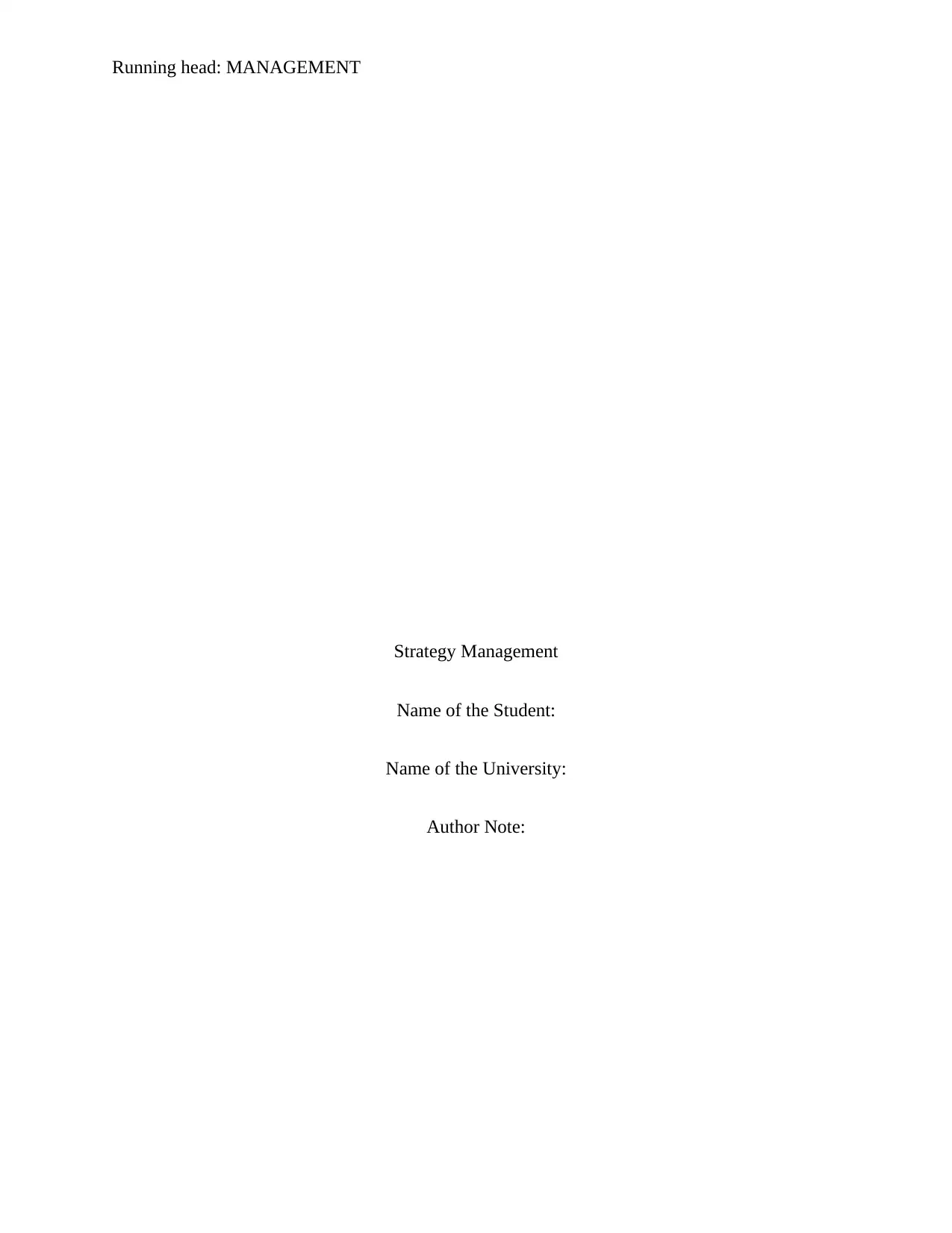
Running head: MANAGEMENT
Strategy Management
Name of the Student:
Name of the University:
Author Note:
Strategy Management
Name of the Student:
Name of the University:
Author Note:
Paraphrase This Document
Need a fresh take? Get an instant paraphrase of this document with our AI Paraphraser
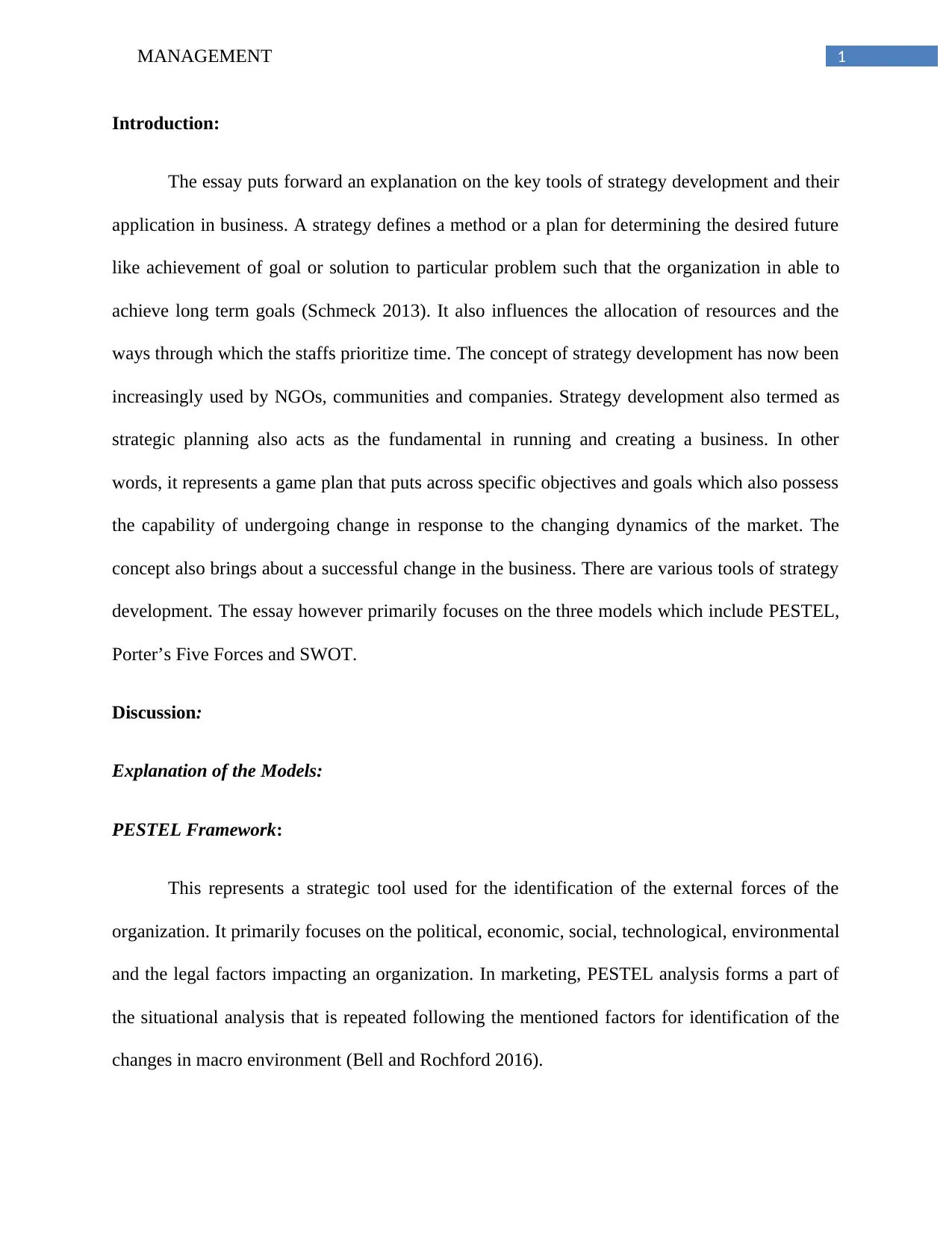
1MANAGEMENT
Introduction:
The essay puts forward an explanation on the key tools of strategy development and their
application in business. A strategy defines a method or a plan for determining the desired future
like achievement of goal or solution to particular problem such that the organization in able to
achieve long term goals (Schmeck 2013). It also influences the allocation of resources and the
ways through which the staffs prioritize time. The concept of strategy development has now been
increasingly used by NGOs, communities and companies. Strategy development also termed as
strategic planning also acts as the fundamental in running and creating a business. In other
words, it represents a game plan that puts across specific objectives and goals which also possess
the capability of undergoing change in response to the changing dynamics of the market. The
concept also brings about a successful change in the business. There are various tools of strategy
development. The essay however primarily focuses on the three models which include PESTEL,
Porter’s Five Forces and SWOT.
Discussion:
Explanation of the Models:
PESTEL Framework:
This represents a strategic tool used for the identification of the external forces of the
organization. It primarily focuses on the political, economic, social, technological, environmental
and the legal factors impacting an organization. In marketing, PESTEL analysis forms a part of
the situational analysis that is repeated following the mentioned factors for identification of the
changes in macro environment (Bell and Rochford 2016).
Introduction:
The essay puts forward an explanation on the key tools of strategy development and their
application in business. A strategy defines a method or a plan for determining the desired future
like achievement of goal or solution to particular problem such that the organization in able to
achieve long term goals (Schmeck 2013). It also influences the allocation of resources and the
ways through which the staffs prioritize time. The concept of strategy development has now been
increasingly used by NGOs, communities and companies. Strategy development also termed as
strategic planning also acts as the fundamental in running and creating a business. In other
words, it represents a game plan that puts across specific objectives and goals which also possess
the capability of undergoing change in response to the changing dynamics of the market. The
concept also brings about a successful change in the business. There are various tools of strategy
development. The essay however primarily focuses on the three models which include PESTEL,
Porter’s Five Forces and SWOT.
Discussion:
Explanation of the Models:
PESTEL Framework:
This represents a strategic tool used for the identification of the external forces of the
organization. It primarily focuses on the political, economic, social, technological, environmental
and the legal factors impacting an organization. In marketing, PESTEL analysis forms a part of
the situational analysis that is repeated following the mentioned factors for identification of the
changes in macro environment (Bell and Rochford 2016).
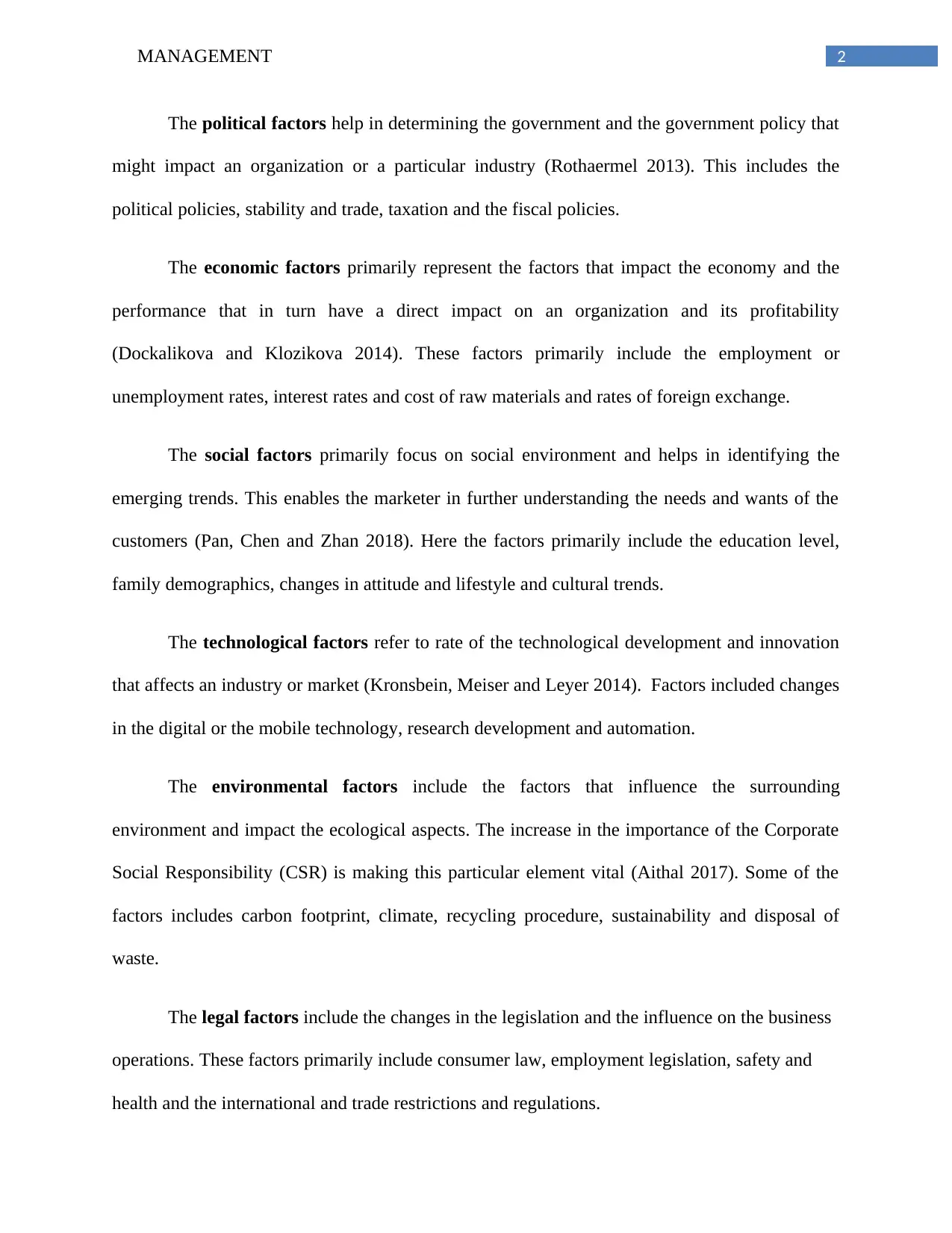
2MANAGEMENT
The political factors help in determining the government and the government policy that
might impact an organization or a particular industry (Rothaermel 2013). This includes the
political policies, stability and trade, taxation and the fiscal policies.
The economic factors primarily represent the factors that impact the economy and the
performance that in turn have a direct impact on an organization and its profitability
(Dockalikova and Klozikova 2014). These factors primarily include the employment or
unemployment rates, interest rates and cost of raw materials and rates of foreign exchange.
The social factors primarily focus on social environment and helps in identifying the
emerging trends. This enables the marketer in further understanding the needs and wants of the
customers (Pan, Chen and Zhan 2018). Here the factors primarily include the education level,
family demographics, changes in attitude and lifestyle and cultural trends.
The technological factors refer to rate of the technological development and innovation
that affects an industry or market (Kronsbein, Meiser and Leyer 2014). Factors included changes
in the digital or the mobile technology, research development and automation.
The environmental factors include the factors that influence the surrounding
environment and impact the ecological aspects. The increase in the importance of the Corporate
Social Responsibility (CSR) is making this particular element vital (Aithal 2017). Some of the
factors includes carbon footprint, climate, recycling procedure, sustainability and disposal of
waste.
The legal factors include the changes in the legislation and the influence on the business
operations. These factors primarily include consumer law, employment legislation, safety and
health and the international and trade restrictions and regulations.
The political factors help in determining the government and the government policy that
might impact an organization or a particular industry (Rothaermel 2013). This includes the
political policies, stability and trade, taxation and the fiscal policies.
The economic factors primarily represent the factors that impact the economy and the
performance that in turn have a direct impact on an organization and its profitability
(Dockalikova and Klozikova 2014). These factors primarily include the employment or
unemployment rates, interest rates and cost of raw materials and rates of foreign exchange.
The social factors primarily focus on social environment and helps in identifying the
emerging trends. This enables the marketer in further understanding the needs and wants of the
customers (Pan, Chen and Zhan 2018). Here the factors primarily include the education level,
family demographics, changes in attitude and lifestyle and cultural trends.
The technological factors refer to rate of the technological development and innovation
that affects an industry or market (Kronsbein, Meiser and Leyer 2014). Factors included changes
in the digital or the mobile technology, research development and automation.
The environmental factors include the factors that influence the surrounding
environment and impact the ecological aspects. The increase in the importance of the Corporate
Social Responsibility (CSR) is making this particular element vital (Aithal 2017). Some of the
factors includes carbon footprint, climate, recycling procedure, sustainability and disposal of
waste.
The legal factors include the changes in the legislation and the influence on the business
operations. These factors primarily include consumer law, employment legislation, safety and
health and the international and trade restrictions and regulations.
⊘ This is a preview!⊘
Do you want full access?
Subscribe today to unlock all pages.

Trusted by 1+ million students worldwide
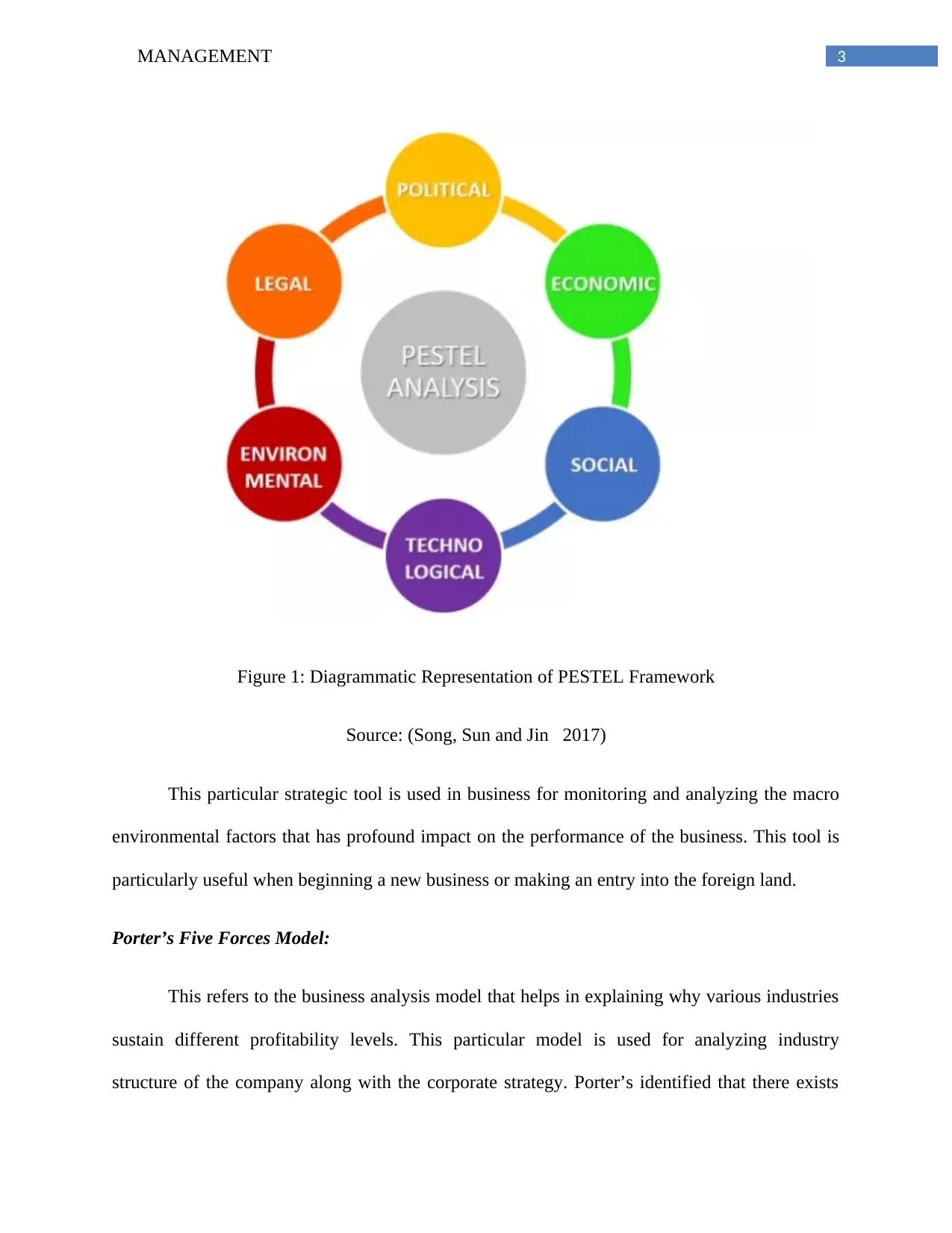
3MANAGEMENT
Figure 1: Diagrammatic Representation of PESTEL Framework
Source: (Song, Sun and Jin 2017)
This particular strategic tool is used in business for monitoring and analyzing the macro
environmental factors that has profound impact on the performance of the business. This tool is
particularly useful when beginning a new business or making an entry into the foreign land.
Porter’s Five Forces Model:
This refers to the business analysis model that helps in explaining why various industries
sustain different profitability levels. This particular model is used for analyzing industry
structure of the company along with the corporate strategy. Porter’s identified that there exists
Figure 1: Diagrammatic Representation of PESTEL Framework
Source: (Song, Sun and Jin 2017)
This particular strategic tool is used in business for monitoring and analyzing the macro
environmental factors that has profound impact on the performance of the business. This tool is
particularly useful when beginning a new business or making an entry into the foreign land.
Porter’s Five Forces Model:
This refers to the business analysis model that helps in explaining why various industries
sustain different profitability levels. This particular model is used for analyzing industry
structure of the company along with the corporate strategy. Porter’s identified that there exists
Paraphrase This Document
Need a fresh take? Get an instant paraphrase of this document with our AI Paraphraser
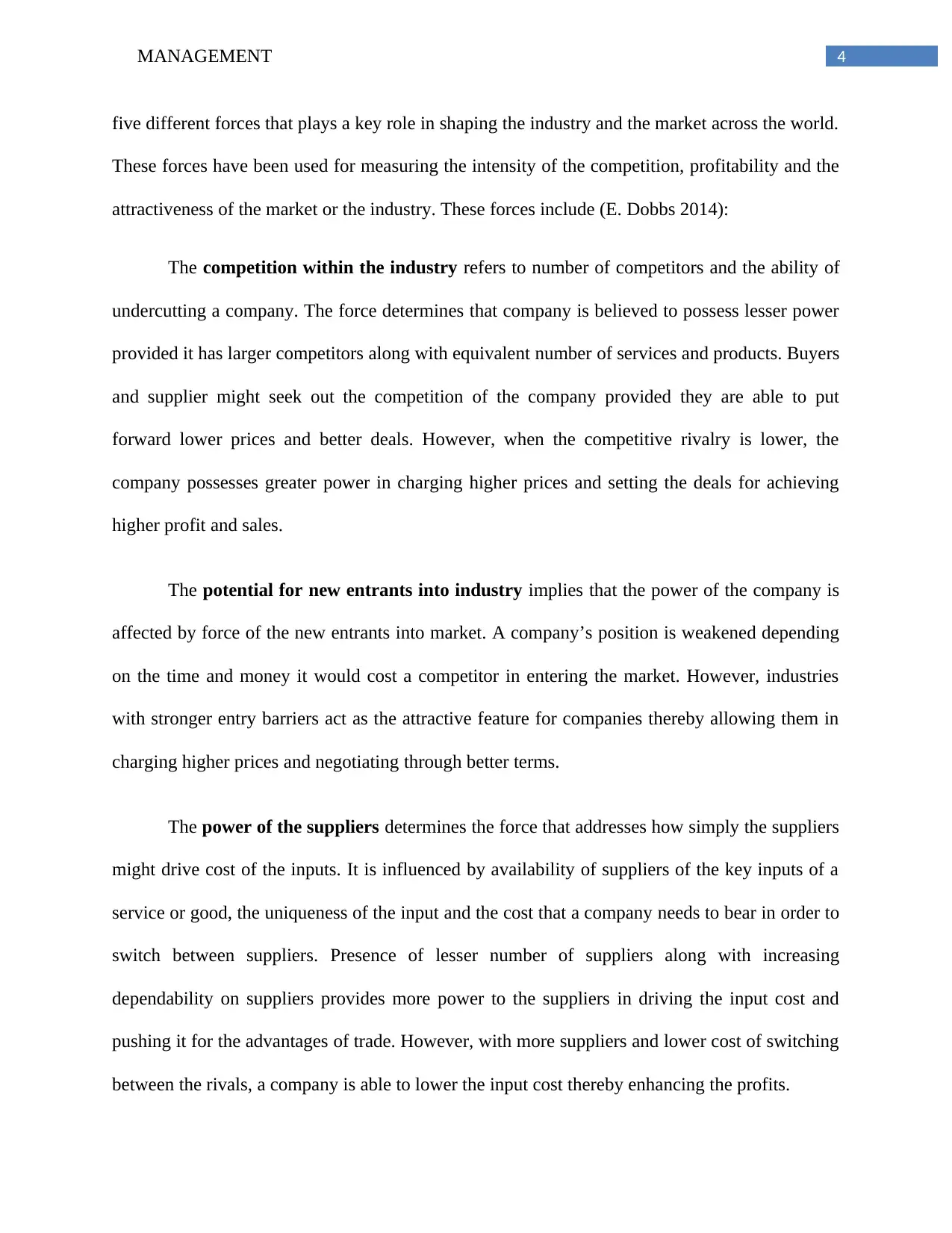
4MANAGEMENT
five different forces that plays a key role in shaping the industry and the market across the world.
These forces have been used for measuring the intensity of the competition, profitability and the
attractiveness of the market or the industry. These forces include (E. Dobbs 2014):
The competition within the industry refers to number of competitors and the ability of
undercutting a company. The force determines that company is believed to possess lesser power
provided it has larger competitors along with equivalent number of services and products. Buyers
and supplier might seek out the competition of the company provided they are able to put
forward lower prices and better deals. However, when the competitive rivalry is lower, the
company possesses greater power in charging higher prices and setting the deals for achieving
higher profit and sales.
The potential for new entrants into industry implies that the power of the company is
affected by force of the new entrants into market. A company’s position is weakened depending
on the time and money it would cost a competitor in entering the market. However, industries
with stronger entry barriers act as the attractive feature for companies thereby allowing them in
charging higher prices and negotiating through better terms.
The power of the suppliers determines the force that addresses how simply the suppliers
might drive cost of the inputs. It is influenced by availability of suppliers of the key inputs of a
service or good, the uniqueness of the input and the cost that a company needs to bear in order to
switch between suppliers. Presence of lesser number of suppliers along with increasing
dependability on suppliers provides more power to the suppliers in driving the input cost and
pushing it for the advantages of trade. However, with more suppliers and lower cost of switching
between the rivals, a company is able to lower the input cost thereby enhancing the profits.
five different forces that plays a key role in shaping the industry and the market across the world.
These forces have been used for measuring the intensity of the competition, profitability and the
attractiveness of the market or the industry. These forces include (E. Dobbs 2014):
The competition within the industry refers to number of competitors and the ability of
undercutting a company. The force determines that company is believed to possess lesser power
provided it has larger competitors along with equivalent number of services and products. Buyers
and supplier might seek out the competition of the company provided they are able to put
forward lower prices and better deals. However, when the competitive rivalry is lower, the
company possesses greater power in charging higher prices and setting the deals for achieving
higher profit and sales.
The potential for new entrants into industry implies that the power of the company is
affected by force of the new entrants into market. A company’s position is weakened depending
on the time and money it would cost a competitor in entering the market. However, industries
with stronger entry barriers act as the attractive feature for companies thereby allowing them in
charging higher prices and negotiating through better terms.
The power of the suppliers determines the force that addresses how simply the suppliers
might drive cost of the inputs. It is influenced by availability of suppliers of the key inputs of a
service or good, the uniqueness of the input and the cost that a company needs to bear in order to
switch between suppliers. Presence of lesser number of suppliers along with increasing
dependability on suppliers provides more power to the suppliers in driving the input cost and
pushing it for the advantages of trade. However, with more suppliers and lower cost of switching
between the rivals, a company is able to lower the input cost thereby enhancing the profits.
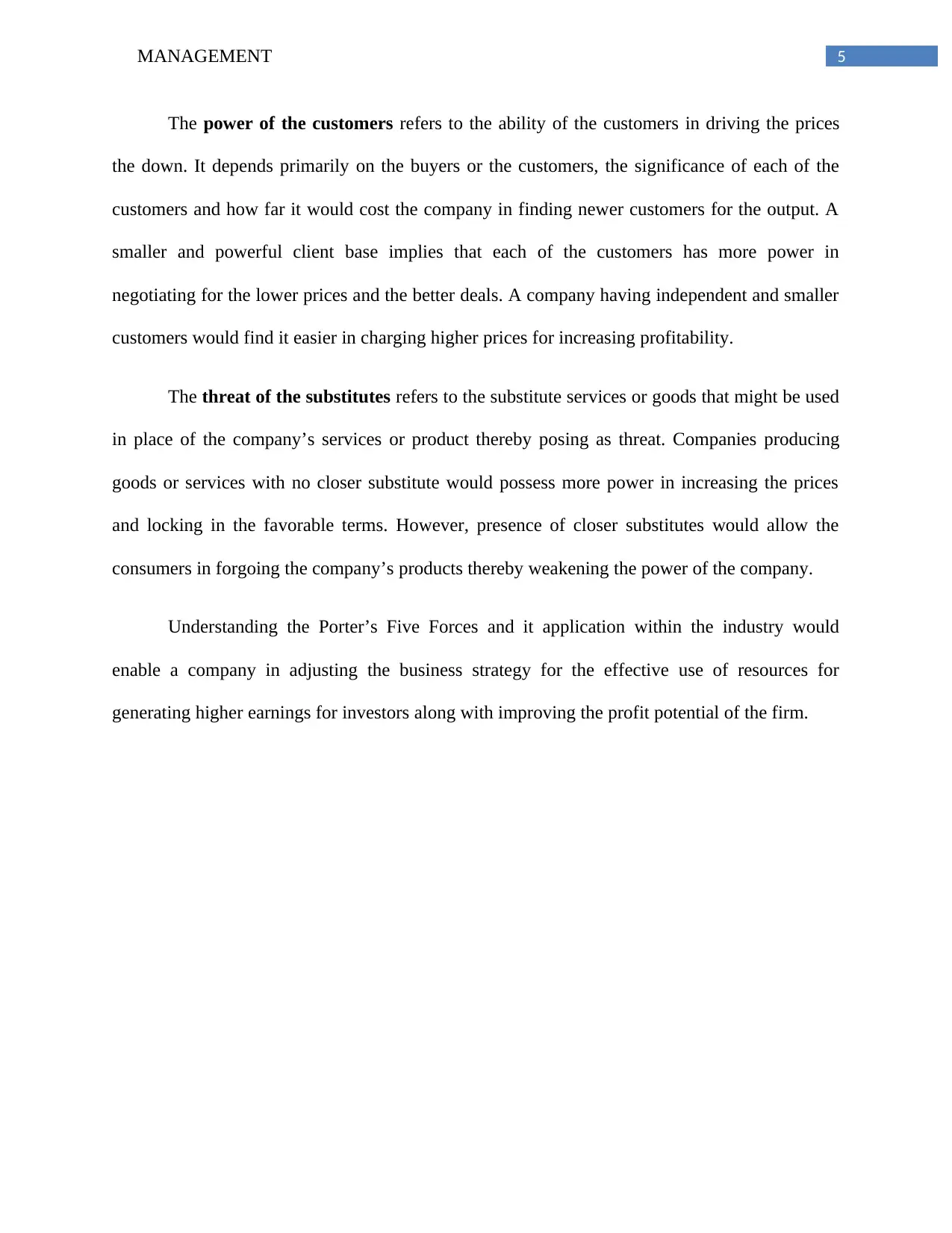
5MANAGEMENT
The power of the customers refers to the ability of the customers in driving the prices
the down. It depends primarily on the buyers or the customers, the significance of each of the
customers and how far it would cost the company in finding newer customers for the output. A
smaller and powerful client base implies that each of the customers has more power in
negotiating for the lower prices and the better deals. A company having independent and smaller
customers would find it easier in charging higher prices for increasing profitability.
The threat of the substitutes refers to the substitute services or goods that might be used
in place of the company’s services or product thereby posing as threat. Companies producing
goods or services with no closer substitute would possess more power in increasing the prices
and locking in the favorable terms. However, presence of closer substitutes would allow the
consumers in forgoing the company’s products thereby weakening the power of the company.
Understanding the Porter’s Five Forces and it application within the industry would
enable a company in adjusting the business strategy for the effective use of resources for
generating higher earnings for investors along with improving the profit potential of the firm.
The power of the customers refers to the ability of the customers in driving the prices
the down. It depends primarily on the buyers or the customers, the significance of each of the
customers and how far it would cost the company in finding newer customers for the output. A
smaller and powerful client base implies that each of the customers has more power in
negotiating for the lower prices and the better deals. A company having independent and smaller
customers would find it easier in charging higher prices for increasing profitability.
The threat of the substitutes refers to the substitute services or goods that might be used
in place of the company’s services or product thereby posing as threat. Companies producing
goods or services with no closer substitute would possess more power in increasing the prices
and locking in the favorable terms. However, presence of closer substitutes would allow the
consumers in forgoing the company’s products thereby weakening the power of the company.
Understanding the Porter’s Five Forces and it application within the industry would
enable a company in adjusting the business strategy for the effective use of resources for
generating higher earnings for investors along with improving the profit potential of the firm.
⊘ This is a preview!⊘
Do you want full access?
Subscribe today to unlock all pages.

Trusted by 1+ million students worldwide
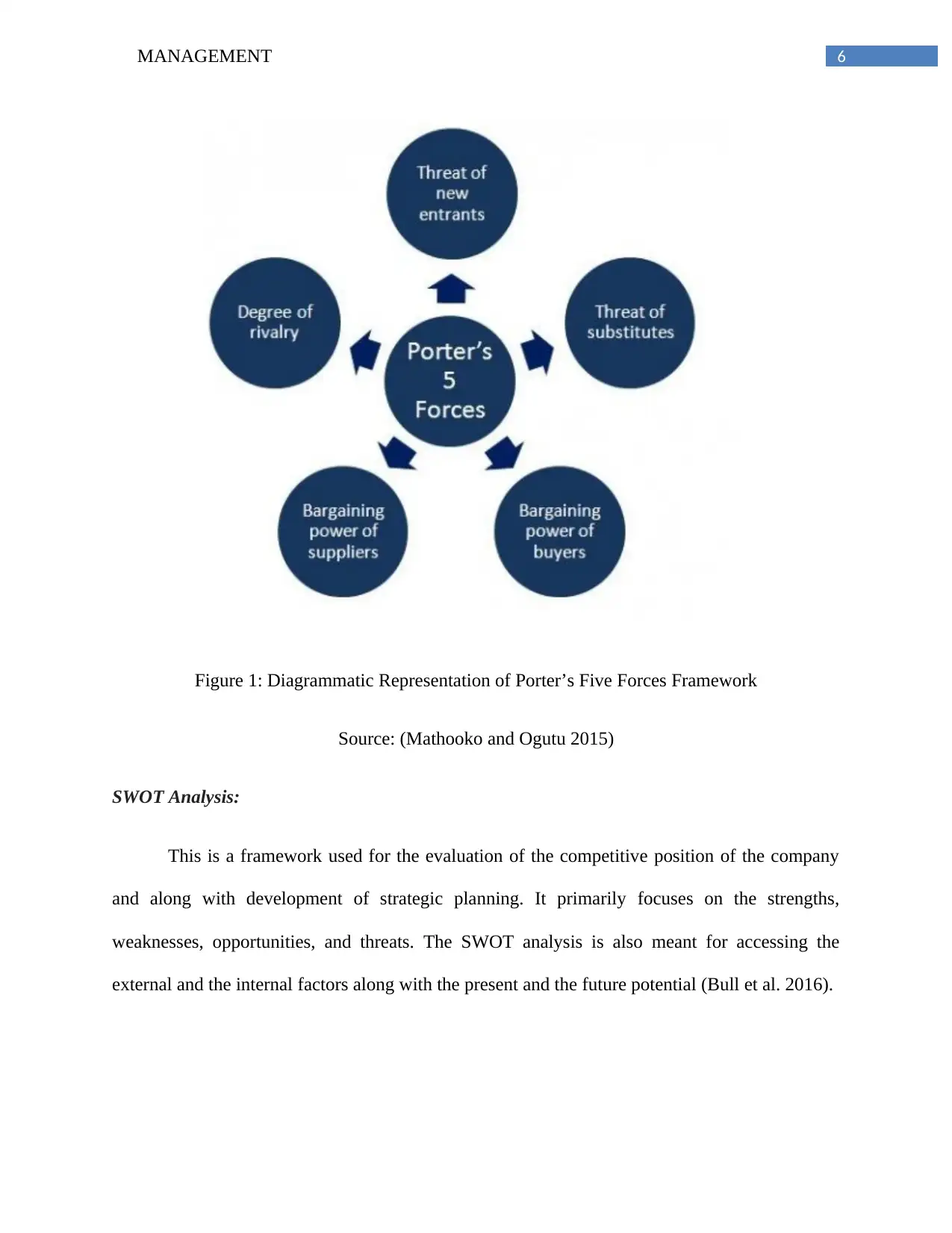
6MANAGEMENT
Figure 1: Diagrammatic Representation of Porter’s Five Forces Framework
Source: (Mathooko and Ogutu 2015)
SWOT Analysis:
This is a framework used for the evaluation of the competitive position of the company
and along with development of strategic planning. It primarily focuses on the strengths,
weaknesses, opportunities, and threats. The SWOT analysis is also meant for accessing the
external and the internal factors along with the present and the future potential (Bull et al. 2016).
Figure 1: Diagrammatic Representation of Porter’s Five Forces Framework
Source: (Mathooko and Ogutu 2015)
SWOT Analysis:
This is a framework used for the evaluation of the competitive position of the company
and along with development of strategic planning. It primarily focuses on the strengths,
weaknesses, opportunities, and threats. The SWOT analysis is also meant for accessing the
external and the internal factors along with the present and the future potential (Bull et al. 2016).
Paraphrase This Document
Need a fresh take? Get an instant paraphrase of this document with our AI Paraphraser
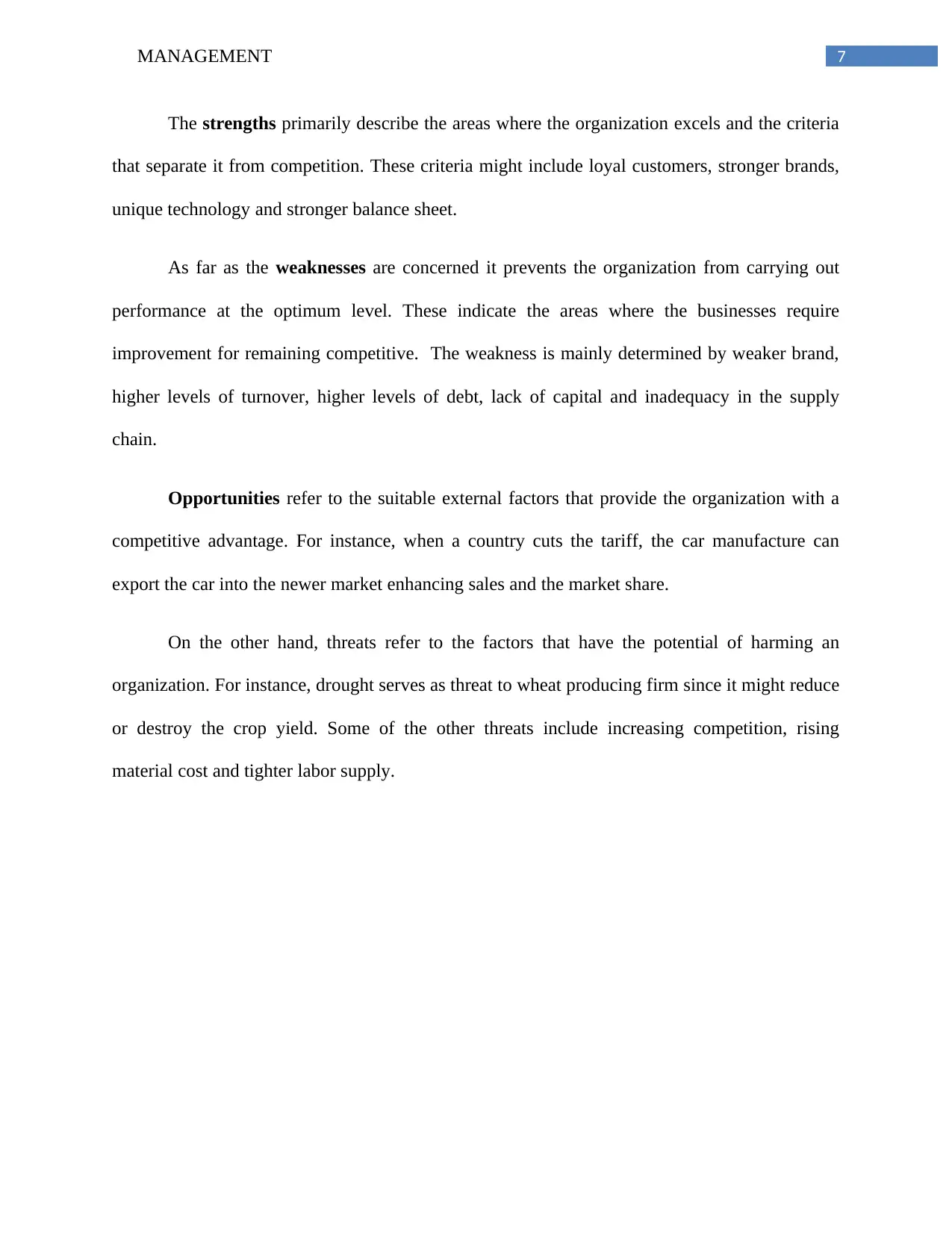
7MANAGEMENT
The strengths primarily describe the areas where the organization excels and the criteria
that separate it from competition. These criteria might include loyal customers, stronger brands,
unique technology and stronger balance sheet.
As far as the weaknesses are concerned it prevents the organization from carrying out
performance at the optimum level. These indicate the areas where the businesses require
improvement for remaining competitive. The weakness is mainly determined by weaker brand,
higher levels of turnover, higher levels of debt, lack of capital and inadequacy in the supply
chain.
Opportunities refer to the suitable external factors that provide the organization with a
competitive advantage. For instance, when a country cuts the tariff, the car manufacture can
export the car into the newer market enhancing sales and the market share.
On the other hand, threats refer to the factors that have the potential of harming an
organization. For instance, drought serves as threat to wheat producing firm since it might reduce
or destroy the crop yield. Some of the other threats include increasing competition, rising
material cost and tighter labor supply.
The strengths primarily describe the areas where the organization excels and the criteria
that separate it from competition. These criteria might include loyal customers, stronger brands,
unique technology and stronger balance sheet.
As far as the weaknesses are concerned it prevents the organization from carrying out
performance at the optimum level. These indicate the areas where the businesses require
improvement for remaining competitive. The weakness is mainly determined by weaker brand,
higher levels of turnover, higher levels of debt, lack of capital and inadequacy in the supply
chain.
Opportunities refer to the suitable external factors that provide the organization with a
competitive advantage. For instance, when a country cuts the tariff, the car manufacture can
export the car into the newer market enhancing sales and the market share.
On the other hand, threats refer to the factors that have the potential of harming an
organization. For instance, drought serves as threat to wheat producing firm since it might reduce
or destroy the crop yield. Some of the other threats include increasing competition, rising
material cost and tighter labor supply.
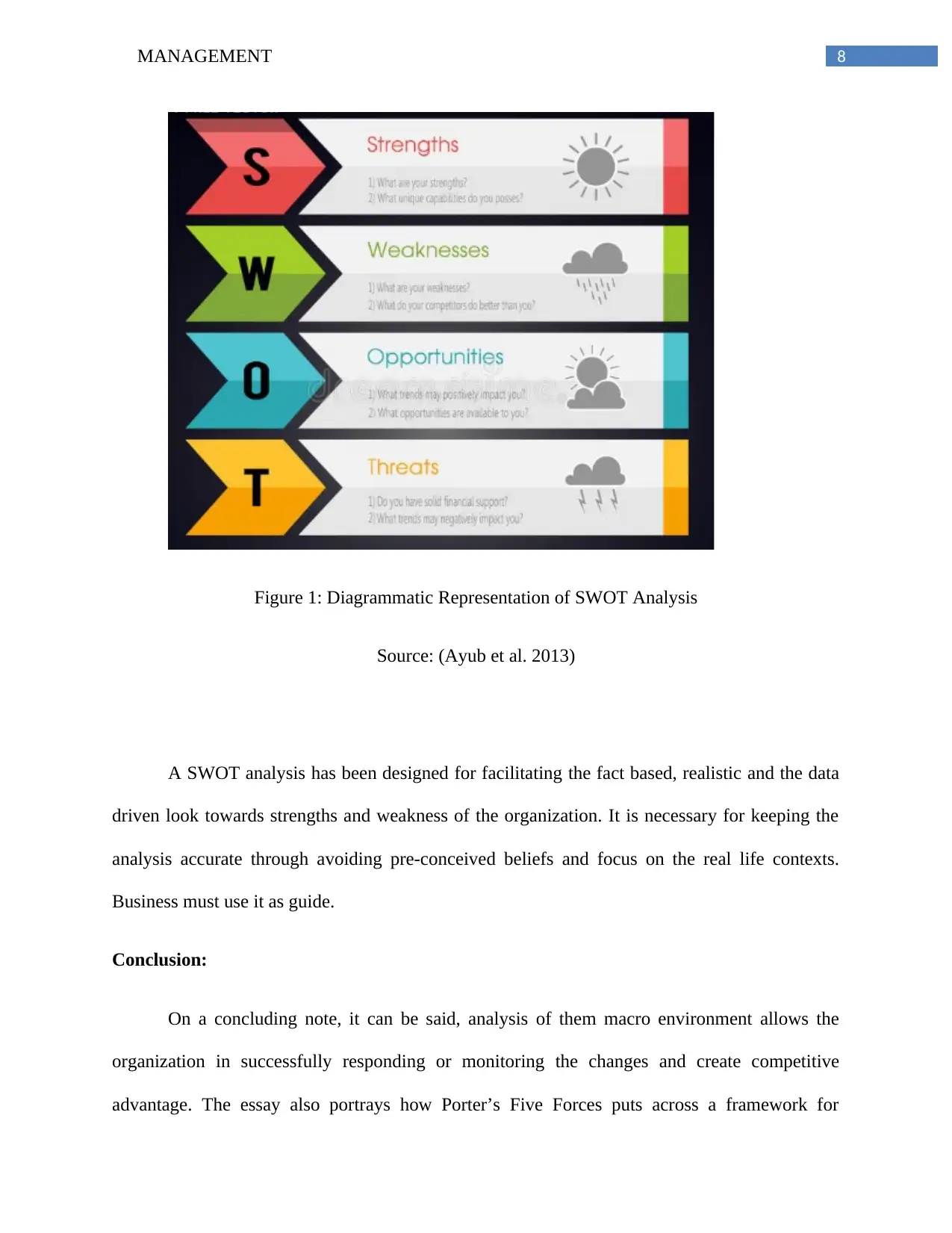
8MANAGEMENT
Figure 1: Diagrammatic Representation of SWOT Analysis
Source: (Ayub et al. 2013)
A SWOT analysis has been designed for facilitating the fact based, realistic and the data
driven look towards strengths and weakness of the organization. It is necessary for keeping the
analysis accurate through avoiding pre-conceived beliefs and focus on the real life contexts.
Business must use it as guide.
Conclusion:
On a concluding note, it can be said, analysis of them macro environment allows the
organization in successfully responding or monitoring the changes and create competitive
advantage. The essay also portrays how Porter’s Five Forces puts across a framework for
Figure 1: Diagrammatic Representation of SWOT Analysis
Source: (Ayub et al. 2013)
A SWOT analysis has been designed for facilitating the fact based, realistic and the data
driven look towards strengths and weakness of the organization. It is necessary for keeping the
analysis accurate through avoiding pre-conceived beliefs and focus on the real life contexts.
Business must use it as guide.
Conclusion:
On a concluding note, it can be said, analysis of them macro environment allows the
organization in successfully responding or monitoring the changes and create competitive
advantage. The essay also portrays how Porter’s Five Forces puts across a framework for
⊘ This is a preview!⊘
Do you want full access?
Subscribe today to unlock all pages.

Trusted by 1+ million students worldwide
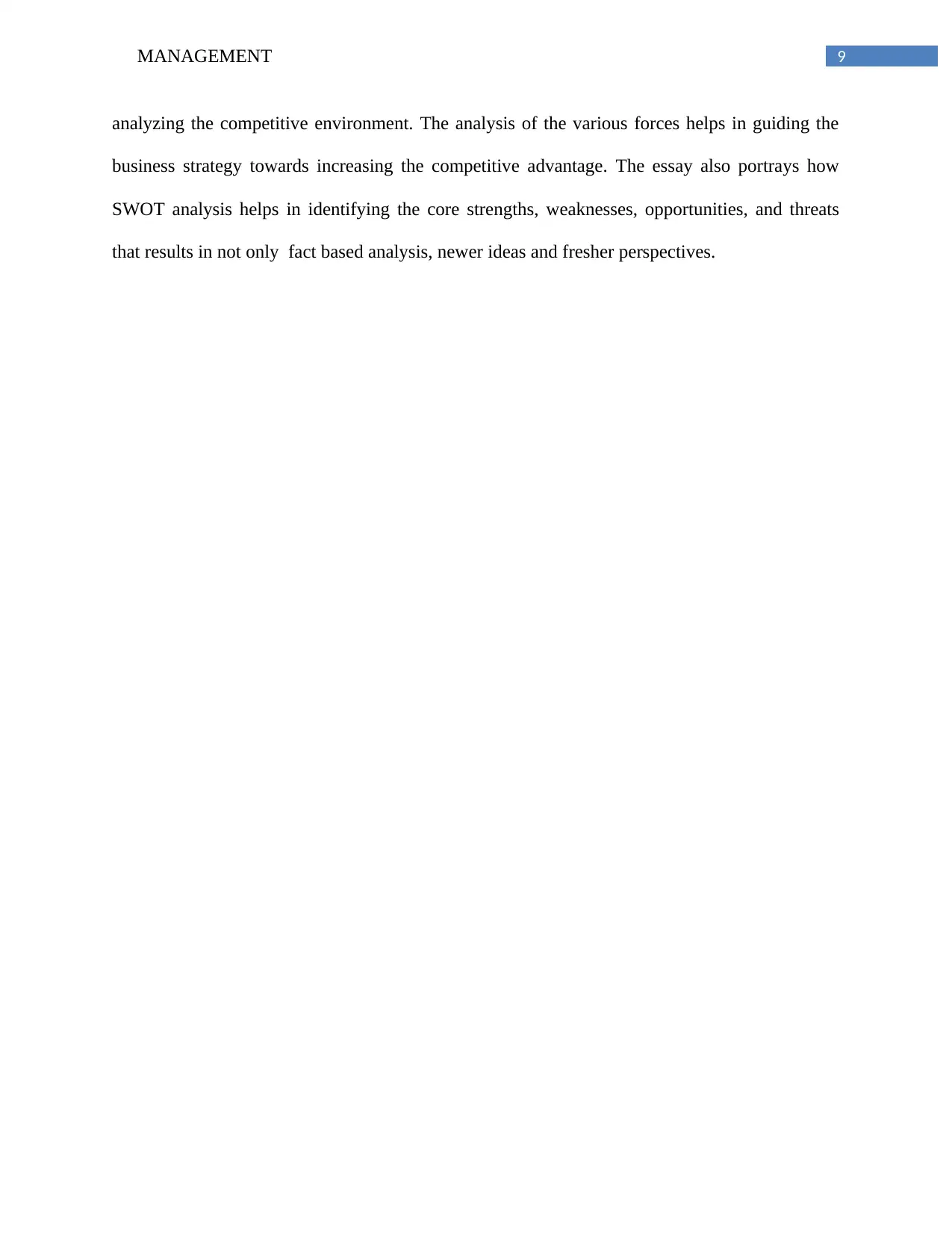
9MANAGEMENT
analyzing the competitive environment. The analysis of the various forces helps in guiding the
business strategy towards increasing the competitive advantage. The essay also portrays how
SWOT analysis helps in identifying the core strengths, weaknesses, opportunities, and threats
that results in not only fact based analysis, newer ideas and fresher perspectives.
analyzing the competitive environment. The analysis of the various forces helps in guiding the
business strategy towards increasing the competitive advantage. The essay also portrays how
SWOT analysis helps in identifying the core strengths, weaknesses, opportunities, and threats
that results in not only fact based analysis, newer ideas and fresher perspectives.
Paraphrase This Document
Need a fresh take? Get an instant paraphrase of this document with our AI Paraphraser
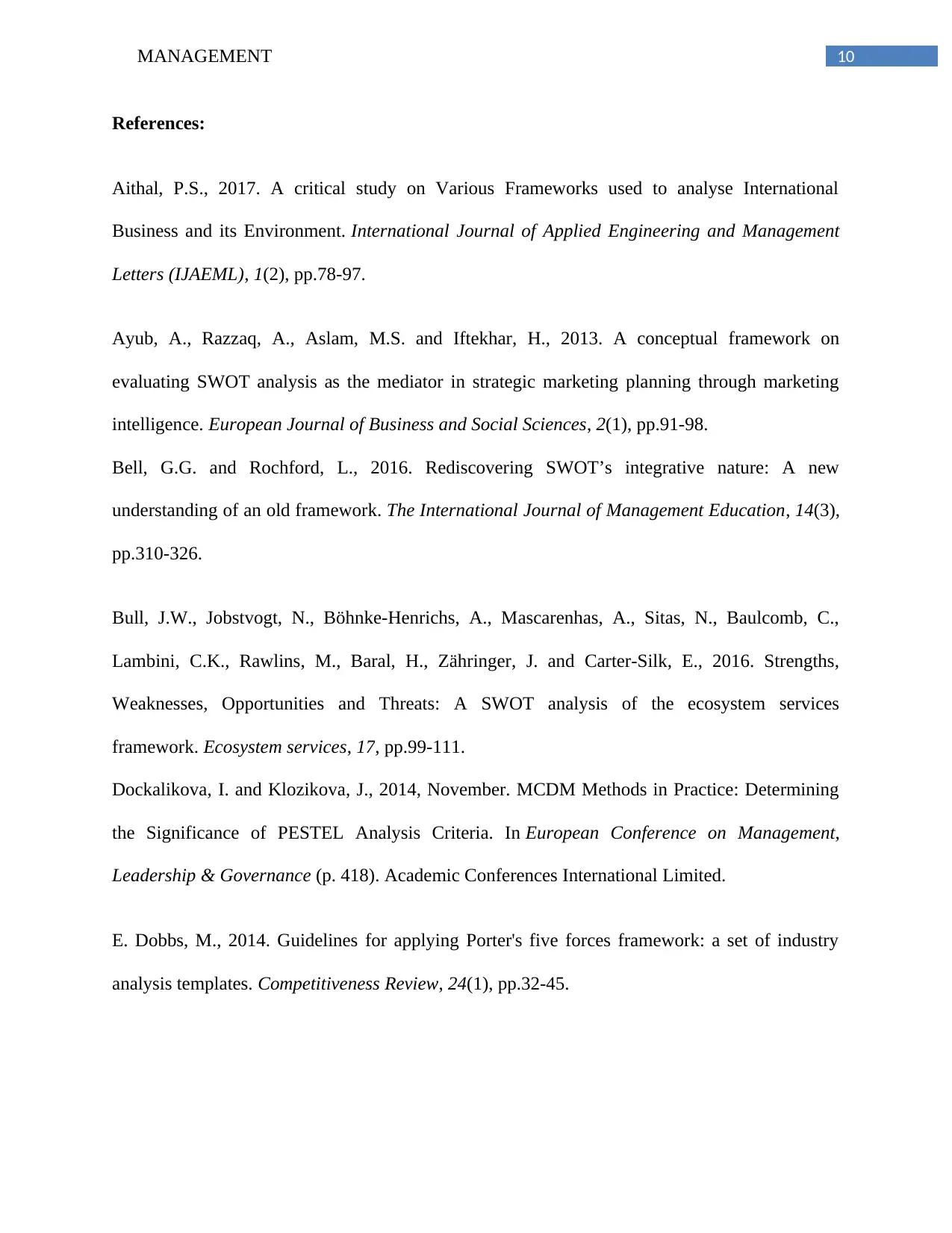
10MANAGEMENT
References:
Aithal, P.S., 2017. A critical study on Various Frameworks used to analyse International
Business and its Environment. International Journal of Applied Engineering and Management
Letters (IJAEML), 1(2), pp.78-97.
Ayub, A., Razzaq, A., Aslam, M.S. and Iftekhar, H., 2013. A conceptual framework on
evaluating SWOT analysis as the mediator in strategic marketing planning through marketing
intelligence. European Journal of Business and Social Sciences, 2(1), pp.91-98.
Bell, G.G. and Rochford, L., 2016. Rediscovering SWOT’s integrative nature: A new
understanding of an old framework. The International Journal of Management Education, 14(3),
pp.310-326.
Bull, J.W., Jobstvogt, N., Böhnke-Henrichs, A., Mascarenhas, A., Sitas, N., Baulcomb, C.,
Lambini, C.K., Rawlins, M., Baral, H., Zähringer, J. and Carter-Silk, E., 2016. Strengths,
Weaknesses, Opportunities and Threats: A SWOT analysis of the ecosystem services
framework. Ecosystem services, 17, pp.99-111.
Dockalikova, I. and Klozikova, J., 2014, November. MCDM Methods in Practice: Determining
the Significance of PESTEL Analysis Criteria. In European Conference on Management,
Leadership & Governance (p. 418). Academic Conferences International Limited.
E. Dobbs, M., 2014. Guidelines for applying Porter's five forces framework: a set of industry
analysis templates. Competitiveness Review, 24(1), pp.32-45.
References:
Aithal, P.S., 2017. A critical study on Various Frameworks used to analyse International
Business and its Environment. International Journal of Applied Engineering and Management
Letters (IJAEML), 1(2), pp.78-97.
Ayub, A., Razzaq, A., Aslam, M.S. and Iftekhar, H., 2013. A conceptual framework on
evaluating SWOT analysis as the mediator in strategic marketing planning through marketing
intelligence. European Journal of Business and Social Sciences, 2(1), pp.91-98.
Bell, G.G. and Rochford, L., 2016. Rediscovering SWOT’s integrative nature: A new
understanding of an old framework. The International Journal of Management Education, 14(3),
pp.310-326.
Bull, J.W., Jobstvogt, N., Böhnke-Henrichs, A., Mascarenhas, A., Sitas, N., Baulcomb, C.,
Lambini, C.K., Rawlins, M., Baral, H., Zähringer, J. and Carter-Silk, E., 2016. Strengths,
Weaknesses, Opportunities and Threats: A SWOT analysis of the ecosystem services
framework. Ecosystem services, 17, pp.99-111.
Dockalikova, I. and Klozikova, J., 2014, November. MCDM Methods in Practice: Determining
the Significance of PESTEL Analysis Criteria. In European Conference on Management,
Leadership & Governance (p. 418). Academic Conferences International Limited.
E. Dobbs, M., 2014. Guidelines for applying Porter's five forces framework: a set of industry
analysis templates. Competitiveness Review, 24(1), pp.32-45.
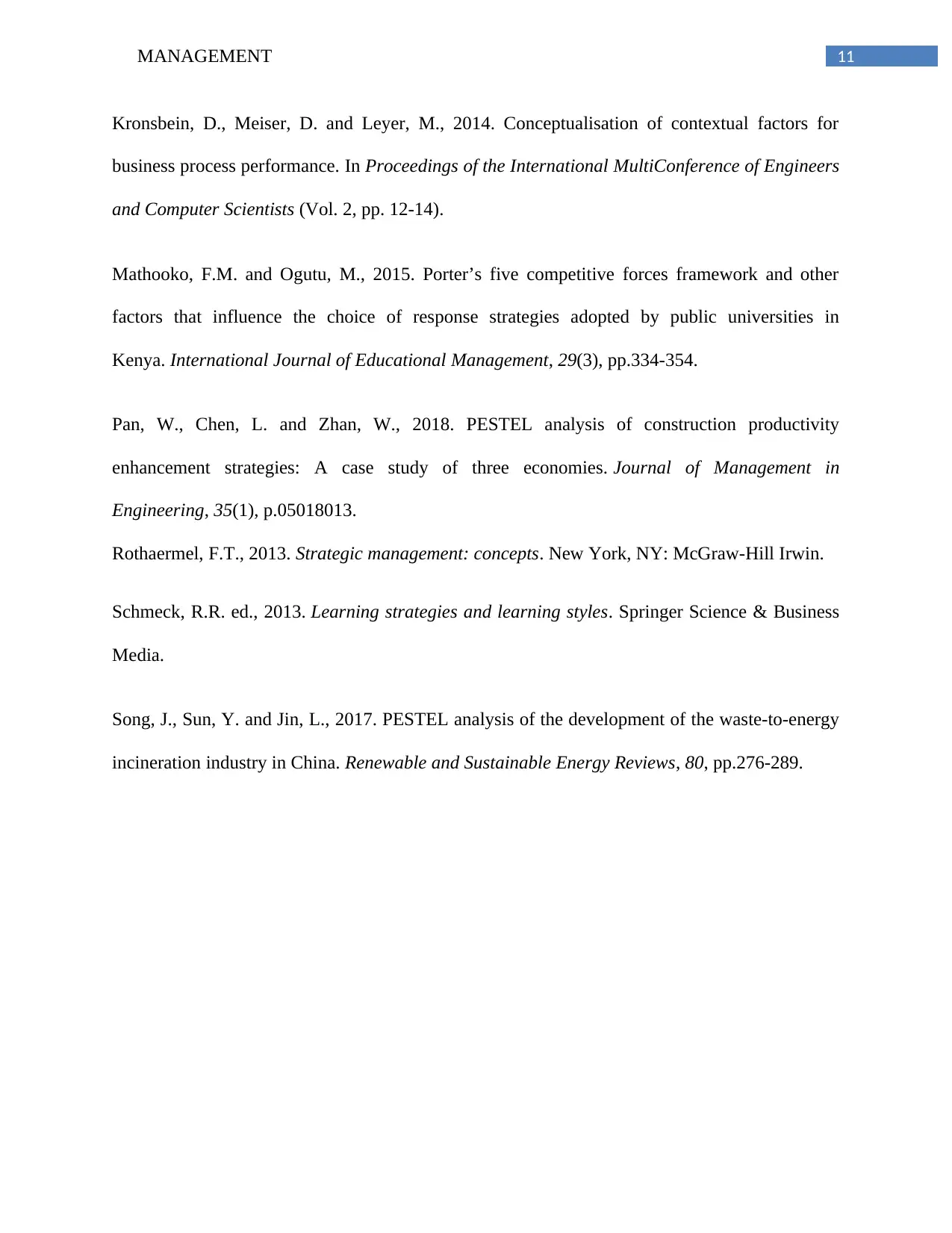
11MANAGEMENT
Kronsbein, D., Meiser, D. and Leyer, M., 2014. Conceptualisation of contextual factors for
business process performance. In Proceedings of the International MultiConference of Engineers
and Computer Scientists (Vol. 2, pp. 12-14).
Mathooko, F.M. and Ogutu, M., 2015. Porter’s five competitive forces framework and other
factors that influence the choice of response strategies adopted by public universities in
Kenya. International Journal of Educational Management, 29(3), pp.334-354.
Pan, W., Chen, L. and Zhan, W., 2018. PESTEL analysis of construction productivity
enhancement strategies: A case study of three economies. Journal of Management in
Engineering, 35(1), p.05018013.
Rothaermel, F.T., 2013. Strategic management: concepts. New York, NY: McGraw-Hill Irwin.
Schmeck, R.R. ed., 2013. Learning strategies and learning styles. Springer Science & Business
Media.
Song, J., Sun, Y. and Jin, L., 2017. PESTEL analysis of the development of the waste-to-energy
incineration industry in China. Renewable and Sustainable Energy Reviews, 80, pp.276-289.
Kronsbein, D., Meiser, D. and Leyer, M., 2014. Conceptualisation of contextual factors for
business process performance. In Proceedings of the International MultiConference of Engineers
and Computer Scientists (Vol. 2, pp. 12-14).
Mathooko, F.M. and Ogutu, M., 2015. Porter’s five competitive forces framework and other
factors that influence the choice of response strategies adopted by public universities in
Kenya. International Journal of Educational Management, 29(3), pp.334-354.
Pan, W., Chen, L. and Zhan, W., 2018. PESTEL analysis of construction productivity
enhancement strategies: A case study of three economies. Journal of Management in
Engineering, 35(1), p.05018013.
Rothaermel, F.T., 2013. Strategic management: concepts. New York, NY: McGraw-Hill Irwin.
Schmeck, R.R. ed., 2013. Learning strategies and learning styles. Springer Science & Business
Media.
Song, J., Sun, Y. and Jin, L., 2017. PESTEL analysis of the development of the waste-to-energy
incineration industry in China. Renewable and Sustainable Energy Reviews, 80, pp.276-289.
⊘ This is a preview!⊘
Do you want full access?
Subscribe today to unlock all pages.

Trusted by 1+ million students worldwide
1 out of 12
Related Documents
Your All-in-One AI-Powered Toolkit for Academic Success.
+13062052269
info@desklib.com
Available 24*7 on WhatsApp / Email
![[object Object]](/_next/static/media/star-bottom.7253800d.svg)
Unlock your academic potential
Copyright © 2020–2025 A2Z Services. All Rights Reserved. Developed and managed by ZUCOL.




